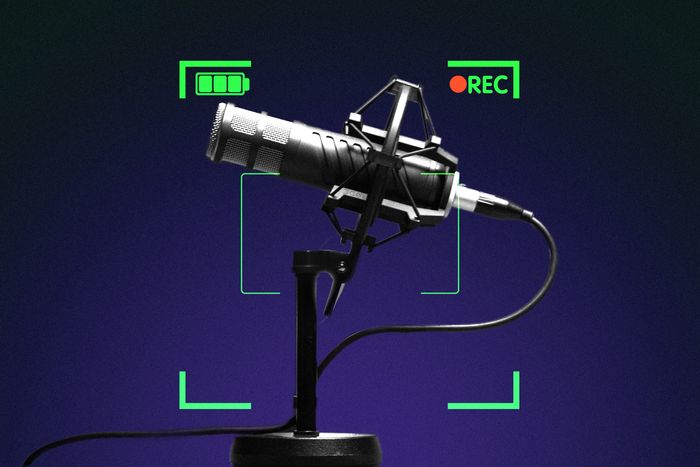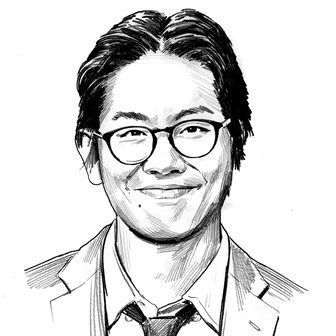
What was the big story of podcasts in 2024? If you ask outside observers of the industry, they might say Joe Rogan and the manosphere, particularly as we roll off the so-called podcast election. But when it comes to the community itself, another answer pops up with greater vociferousness: video, video, video.
And for good reason. 2024 saw large swathes of the industry reorient itself around video. The Ringer, for example, is increasingly packaging its shows for the format, either as full episodes or as marketing materials over social media, as is NPR, Slate, and our parent company, Vox Media, among others; they join a growing share of podcast operations that were multimedia to begin with, like Barstool Sports. The transformation is widespread enough that the archetypal image of a podcaster — host and guest sitting in an aesthetically generic room amid several SM7B mics, hanging out and gabbing away — is now a visual trope across the internet. “It’s become impossible to scroll any social-media platform for more than five seconds and not come across several videos of people talking into microphones,” says Shea Serrano, co-host of the Six Trophies podcast (also available on YouTube).
After about two decades of primarily being associated with audio, video has become central to podcasting’s identity. YouTube is now said to be its biggest distribution point. Chat shows, long podcasting’s bread-and-butter format, have reasserted their standing as the face of the medium — a face you can now literally see. The reality of this growing video-centrism is starting to settle in, and the podcast community is still grappling with what it means. “I initially thought video would be a passing trend, but now it seems there’s a real audience preference for this type of podcast,” said one executive at a platform. “I’m blown away by how quickly video has become central to how most listeners think about podcasting.”
This was the primary sentiment that emerged when I surveyed more than 60 people around the podcast world: hosts, producers, executives, engineers, publicists, agents. I asked them to discuss what they believed was the defining podcast trend from the year and gave them the option to speak anonymously. The medium’s swing to video was, by far, the trend that the overwhelming majority of respondents answered with and had strong feelings about. Here’s what they said about it.
The Arguments for and Against Video
A small but vocal portion of people were unambiguous advocates for the shift to video (“Love it!” one host of a video podcast wrote), and they generally argue that it’s necessary to reach people where they are. The more tempered advocates point to how its value lies in the way existing infrastructures of digital video ultimately solve the problem of discovery long bemoaned by podcasters. “Traditional search is essentially useless for audio, so discovery is happening almost entirely in social video, which means the impulse to be found is likely to be the thing that drives decision-making about show content and, ultimately, form,” said Jon Caramanica, co-host of the Popcast.
But many more respondents expressed wariness over the sudden video craze with some worrying that it’s likely short-sighted. “Really, really not a fan,” said one executive at a British podcast studio. “Wish we were spending as much time and investment trying to habituate listeners to subscriptions so our work could be less dependent on advertising.”
One common critique that emerged is how video podcasting chiefly benefits one specific kind of show: nonnarrative chatcasts that are live-to-tape. Practically every other kind of format, including narrative, magazine shows, and more-edited iterations of interview shows, do not naturally translate to video or map onto the YouTube consumer’s appetite in a straightforward way.
This relates to another anxiety: that embracing video so wholeheartedly cedes too much power to YouTube, and the big tech platforms more generally, which would deepen the risk of podcast publishers being too beholden to the capriciousness of tech companies, which might change platform incentives on a whim.
Still, some respondents conceded the reality that more and more people equate podcasting with video, and specifically YouTube, with each passing day and that there exists very real opportunities to access greater reach and revenue over those mature platforms. But they also think that there’s a need for more nuance in how to talk about developing a video strategy — or if it even makes sense at all. “It’s not a ‘one-size-fits-all’ conversation,” a publicist wrote. “Video is going to be different scales to different shows, and that is okay. Let’s make it known that it’s okay so people are not freaking out and then changing their show in ways it’s not intended.”
But Are “Listeners” and “Viewers” Valuable in the Same Way?
There is also an all-in-one way many in the industry talked about the relationship between the audio and video versions of a podcast. “Part of the podcast presidential election that is craziest to me is that the video versions of these shows (Joe Rogan, Alex Cooper, Theo Von) absolutely crushed the comparable audio-only podcast versions of the same episodes,” said Jason Hoch, head of the podcast studio Wavland. “It almost makes the traditional audio-only podcast format, delivered in an app, feel small and quaint.” Be that as it may, an apples-to-apples comparison is not quite an appropriate way to read the relationship between the two formats, given that an individual YouTube view and an individual podcast-episode impression don’t mean the same thing, nor are they counted the same way in terms of monetization and as a measure of audience engagement.
In any case, as several respondents wondered aloud, are people actually looking at these videos? “I’m curious about how many of the people listening to podcasts through YouTube are actually watching the videos,” wrote Dan Pashman, host of The Sporkful. “I often listen to music through YouTube because it has concert recordings that aren’t on Spotify, but I’m not watching the videos.”
Gender Biases
There are also more specific critiques about what an increased emphasis on visuals will bring to the dynamics of who gets to succeed in podcasting, like the potential for greater gender biases. “We are used to men looking as they semi-sort of actually do on video,” wrote one host, a woman who leads an audio-only podcast. “We are not used to this for women. Anytime you are asking a woman to get on-camera, it is a true ask: Either they have to do all the work to get camera ready — or take the risk of not being camera ready.”
This person continued, “It’s a lot easier to be a podcast-bro figurehead, with all the aesthetic casual-ness implicit in that, than whatever the female equivalent might be; the fact that the equivalent might be someone like Alex Cooper speaks to exactly what I’m talking about!”
Another host, a woman who makes audio-only narrative projects, put things more bluntly: “If we wanted to be in TV, we would’ve gone into broadcast journalism, not jumped from print to podcasting.”
Does the Rise of Video Mean the Decline of Audio?
Another concern is how the natural demands of being on-camera might ultimately undermine certain core audio-first advantages that made the medium so popular in the first place. “Part of the authenticity, intimacy, and integrity of podcasting originally was because it didn’t need to feel performative and done for a camera,” said Steven Ray Morris, a producer at Maximum Fun. “It was about creating a space in the room that felt safe and encouraged discovery.”
The Memory of Pivot-to-Video
The surging fervor around video has also led some I spoke to, particularly those who have been around digital media for a while, to recall the “Pivot-to-Video” era of the mid-2010s, which saw media companies rush toward allocating resources to producing video content off the financial and structural encouragement by major social-media platforms like Facebook … only for their business models to implode when those platforms eventually pulled away from video.
Some of the more polemical responses to my survey framed podcasting’s pivot to video as a by-product of major tech platforms, specifically Spotify and YouTube, cynically redefining the concept of a podcast to further fuel their attacks on one another. “Spotify is trying to eat YouTube’s market share, and podcasts are getting caught in the crossfire,” said Amanda McLoughlin, the co-founder of Multitude Productions. “Their pivot to video isn’t about us; it’s about entreating YouTubers to cross-post their content as Google gets more and more complacent.”
Is Podcasting Set to Fracture?
Looming over everything is a growing anxiety that podcasting’s shift to video threatens to fracture the ecosystem in some permanent way; that the rise of video chatcasts, spearheaded by super-popular shows like The Joe Rogan Experience and Call Her Daddy, will come at the expense of everyone else, not just widening the gulf between the haves and the have-nots but leading to an industry that simply won’t support anything that does not conform to the chatcast video format.
Then again, one respondent mentioned an intriguing theory that not all platforms are necessarily competing in the same manner. “I think podcasting might be starting to sort itself by platform,” said Ian Coss, host of The Big Dig. “YouTube and Spotify feel like homes for the big tent video-based chatcasts. Apple feels like it’s making itself the home for the more narrative, public-radio-adjacent shows that don’t translate so cleanly to video.”
But there is perhaps a more positive way to view such a development. If the rise of video is causing a kind of identity crisis within podcasting, then viewing the ecosystem fracturing or splintering into separate different ecosystems might be the only productive way to frame the path forward. And in order to do that, as host and executive producer Ronald Young Jr. argues, the podcast community probably needs new concepts and even words to support thinking about the medium in a more complex way.
“This may present an opportunity for shows that are not interview or chat to further distance themselves from what is considered to be a podcast,” Young Jr. said. “Like, for instance, there’s a separation between listening to ‘the radio’ and listening to ‘talk radio.’ We just haven’t seen the new language emerge yet.”


